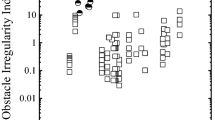Abstract
Experimental studies were carried out to investigate the effects of different ignition source locations and wall obstructions in a partially opened chamber, 235 mm in height, with a 1,000×950 mm2 cross section and with a large top-venting of area of 1,000×320mm2. Four different ignition positions such as the bottom, side, corner and top, and three wall obstacles with blockage ratios ranging from about 10 to 30% were used. The comparisons between wall obstacles in the chamber showed that the dependence of overpressure on obstruction ratios was different compared with published experiments with a large L/D ratio enclosure. This may be linked to the characteristics of the chamber. The smallest wall obstacle caused the highest overpressure, while the largest one caused the lowest overpressure. The flame propagation and pressure development were highly sensitive to the ignition positions. The bottom ignition caused the highest overpressure, while the top ignition the closest to the vent opening caused the lowest overpressure.
Similar content being viewed by others
References
D. J. Park and Y. S. Lee, Korean J. Chem. Eng., 26, 313 (2009).
D. K. Pritchard, D. J. Freeman and P.W. Guilbert, J. Loss Prevention in the Process Industries, 9, 205 (1996).
H. Phylaktou and G. E. Andrews, Combust. Sci. Technol., 77, 27 (1991).
G. K. Hargrave, S. J. Jarvis and T. C. Williams, Measurement Sci. Technol., 13, 1036 (2002).
I. O. Moen, M. Donato, R. Knystautas and J. H. Lee, Combust. Flame, 39, 21 (1980).
A. R. Masri, S. S. Ibrahim, N. Nehzat and A. R. Green, Exp. Therm. Fluid Sci., 21, 109 (2000).
S. S. Ibrahim, G. K. Hargrave and T. C. Williams, Exp. Therm. Fluid Sci., 24, 99
O. C. Ellis and R.V. Wheeler, J. Chem. Soc., 2, 3215 (1928).
W. A. Kirkyby and R.V. Wheeler, J. Chem. Soc., 2, 3203 (1928).
D. M. Solberg, J. A. Pappas and E. Skramstad, Eighteenth Symposium (International) on Combustion, Combustion Institute, 1607 (1981).
A.R. Green and N. Nehzat, Proceedings Queensland Mining Industry Heath and Safety Conference, 240 (1999).
J. Kindracki, A. Kobiera, G. Rarata and P. Wolanski, J. Loss Prevention in the Process Industries, 20, 551 (2007).
D. J. Park, A. R. Green, Y. S. Lee and Y. C. Chen, Combust. Flame, 150, 27 (2007).
D. J. Park, T. S. Lee and Y. S. Lee, J. KOSOS, 23, 81 (2008).
Author information
Authors and Affiliations
Corresponding author
Rights and permissions
About this article
Cite this article
Park, D.J., Lee, Y.S. Experimental investigation of explosion pressures and flame propagations by wall obstruction ratios and ignition positions. Korean J. Chem. Eng. 29, 139–144 (2012). https://doi.org/10.1007/s11814-011-0159-5
Received:
Accepted:
Published:
Issue Date:
DOI: https://doi.org/10.1007/s11814-011-0159-5




